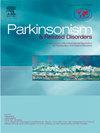Immunomodulatory effects of invasive and non-invasive brain stimulation in Parkinson's disease
IF 3.1
3区 医学
Q2 CLINICAL NEUROLOGY
引用次数: 0
Abstract
Accumulating evidence points to a critical role of the immune system in the neurodegenerative process in Parkinson's disease (PD). This late knowledge has revolutionised our understanding of the pathogenetic mechanisms underlying PD and has opened new avenues toward disease-modifying rather than dopamine-replacement therapeutic approaches. When pharmacological treatments fail to adequately alleviate clinical symptoms, brain stimulation techniques are taken into consideration. Deep brain stimulation (DBS) constitutes the most common method for invasive brain stimulation, while the non-invasive brain stimulation paradigms comprise among others repetitive transcranial magnetic stimulation (rTMS), transcranial direct current stimulation (tDCS) and transcranial alternating current stimulation (tACS). How each brain stimulation paradigm interferes with disease pathogenesis still remains elusive. In light of recent evidence supporting the involvement of the immune system in PD, a question that arises is whether brain stimulation techniques have an immunomodulatory potential. Here, we summarize the existing knowledge and provide mechanistic insights that should foster future research. Overall, it appears that DBS and rTMS can modulate both the central and the peripheral component of the immune system and can lead to clinical improvement through immunosuppressive/anti-inflammatory mechanisms. The paucity of evidence for tDCS and tACS precludes any conclusions and highlights the necessity of more mechanistic studies focusing on their immunomodulatory potential, if any. Any pre-clinical findings warrant further clinical validation using human in vivo markers and post-mortem human brain tissue. Unravelling the mechanisms that underpin the beneficial therapeutic effects of brain stimulation in PD patients can contribute substantially to the fine-tuning of the current stimulation protocols and pave the way for more efficient and clinically meaningful neuromodulation paradigms.
求助全文
约1分钟内获得全文
求助全文
来源期刊

Parkinsonism & related disorders
医学-临床神经学
CiteScore
6.20
自引率
4.90%
发文量
292
审稿时长
39 days
期刊介绍:
Parkinsonism & Related Disorders publishes the results of basic and clinical research contributing to the understanding, diagnosis and treatment of all neurodegenerative syndromes in which Parkinsonism, Essential Tremor or related movement disorders may be a feature. Regular features will include: Review Articles, Point of View articles, Full-length Articles, Short Communications, Case Reports and Letter to the Editor.
 求助内容:
求助内容: 应助结果提醒方式:
应助结果提醒方式:


